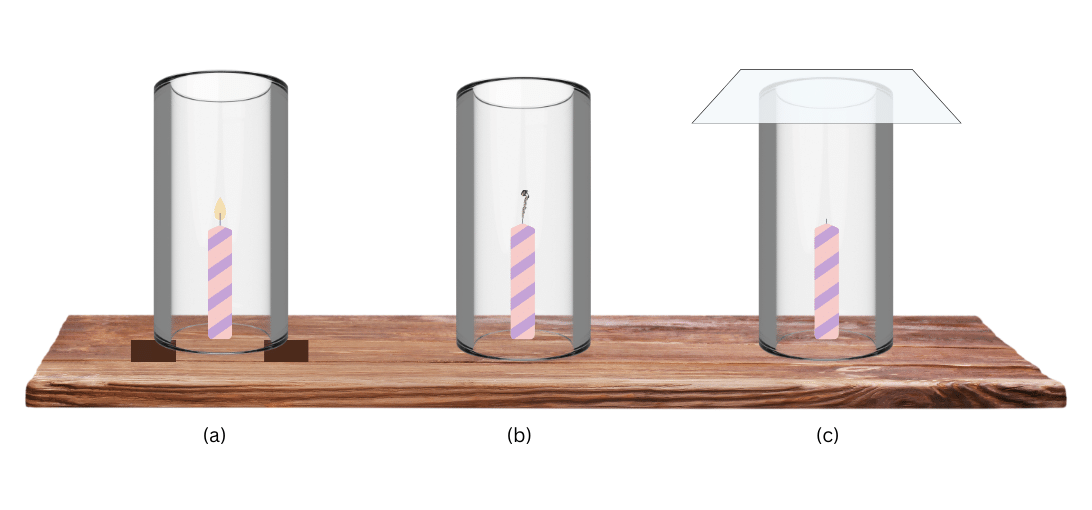2. Complete Activity 4.2 (Page 41). (Caution: Be careful while handling burning candle). Fix a lighted candle on a table. Put a glass chimney over the candle and rest it on a few wooden blocks in such a way that air can enter the chimney [Fig. 4.2(a)]. Observe what happens to the flame. Now remove the blocks and let the chimney rest on the table [Fig. 4.2(b)]. Again observe the flame. Finally, put a glass plate over the chimney [Fig. 4.2(c)]. Watch the flame again. What happens in the three cases? Does the flame flicker off? Does it flicker and give smoke? Does it burn unaffected? Can you infer anything at all about the role played by air in the process of burning?
Answer:
Answer: The above activity can be carried out as follows:
Aim: To observe what happens to the candle in the three cases and make the necessary conclusions.
Materials Required: Candle, glass chimney, wooden blocks, glass plate.
Procedure:
(i) Light the candle carefully and fix it on the table.
(ii) Case (a): Place the glass chimney over the candle and rest it on the wooden blocks as shown in(a). Observe what happens to the flame.
(iii) Case (b): Now remove the blocks and let the chimney rest on the table and observe what happens to the flame.
(iv) Case (c): Finally put a glass plate over the chimney and observe what happens to the flame.

Observations:
We observe that:
- The candle burns freely in case (a).
- The candle flickers and produces smoke in case (b).
- The flame goes off after a while in case (c).
Conclusions:
We conclude that:
- In case (a), the candle burns freely because air can enter the chimney from below and above.
- In case (b), the candle flickers and produces smoke because air can only enter the chimney from above and not below. There is insufficient air to support complete burning.
- In case (c), the flame finally goes off when there is no more air left inside the chimney for burning.
- It is proved that air is necessary for combustion.
“(Caution: Be careful while handling burning candle). Fix a lighted candle on a table. Put a glass chimney over the candle and rest it on a few wooden blocks in such a way that air can enter the chimney [Fig. 4.2(a)]. Observe what happens to the flame. Now remove the blocks and let the chimney rest on the table [Fig. 4.2(b)]. Again observe the flame. Finally, put a glass plate over the chimney [Fig. 4.2(c)]. Watch the flame again. What happens in the three cases? Does the flame flicker off? Does it flicker and give smoke? Does it burn unaffected? Can you infer anything at all about the role played by air in the process of burning?” – Solved.
Related Links:
Solution to Extended Learning Problem 1
Solution to Extended Learning Problem 2
Solution to Extended Learning Problem 3
Solution to Extended Learning Problem 4
Solution to Extended Learning Problem 5
Solution to Activity 4.1
Solution to Activity 4.3
Solution to Activity 4.4
Solution to Activity 4.5


